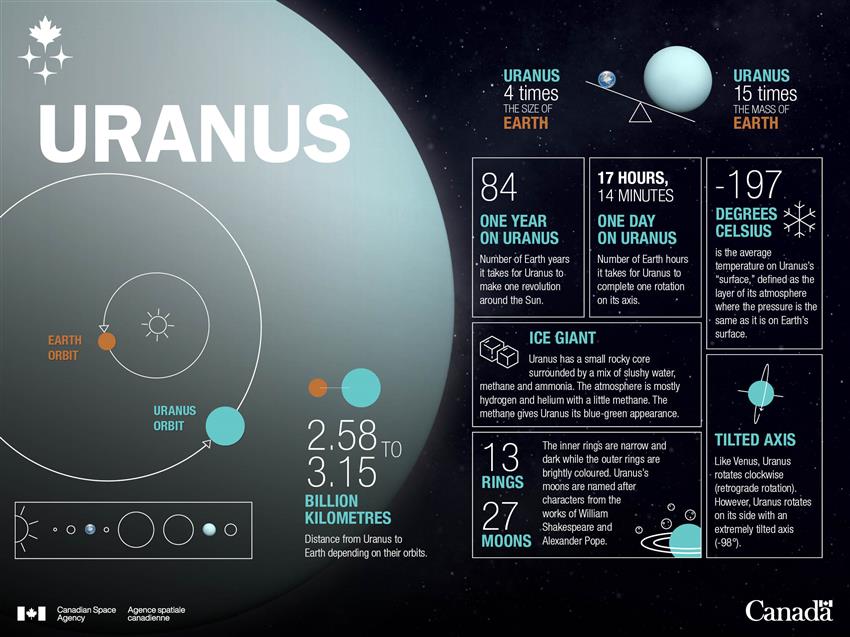Uranus
About Uranus
| Type | Ice giant |
|---|---|
| Size (diameter) | 50,724 km, or about 4 Earths |
| Mass | 8.7 × 1025 kg, or about 15 Earths |
| Length of a year (orbital period) | 84 years |
| Number of moons | 27 |
| Average distance from the Sun | 2.9 billion km |
| Temperature | Between -226 and -197 degrees Celsius |

A view of Uranus taken by the Voyager 2 probe in . (Credit: NASA/JPL)
Formation
Uranus is the seventh planet from the Sun and is considered an ice giant because it is largely made up of water, ammonia, and methane in solid form. Like all the other planets, Uranus was likely formed in a massive, ancient cloud of gas, dust, and ice that collapsed into a spinning disc. Our Sun was born at its centre, and the planets were created about 4.5 billion years ago from particles sticking together along rings in the disc. Scientists believe the differences between ice giants and gas giants (like Saturn and Jupiter) are due to their slightly different formation histories.
Except for Earth, the names of all the planets in our solar system are derived from gods of Roman and Greek mythology:
- Mercury is the fastest planet, and is named after Hermes, the swift messenger of the gods in the Greek tradition.
- Jupiter is named after the Roman ruler of the gods, commonly known as Zeus in Greek mythology.
- Uranus is named after the Greek god of the sky, who was also Zeus's grandfather.
Moons are often given names related to that of their planet. Mars's moons, Phobos and Deimos, "Fear
" and "Terror,
" were the twin sons of the god of war. Uniquely, many of Uranus's moons bear the names of characters from English literature.
Rotation, orbit, and tilt
A day on Uranus lasts about 17 hours. Interestingly, different parts of Uranus rotate at different speeds: while the interior of the planet spins in that time, its upper atmosphere completes a full rotation three hours faster, which creates some of the most violent winds in the solar system. Near Uranus's poles, they blow in the same direction as the rotation of the planet. Closer to the equator, the winds blow in the opposite direction!
Uranus takes 84 years to complete one full orbit around the Sun.
Instead of rotating vertically like all of the other planets, Uranus spins around a horizontal axis. Scientists believe that an Earth-sized planet may have collided with Uranus and knocked it on its side.
Uranus's dramatic 98-degree tilt gives rise to the most extreme seasons in the solar system. For nearly 21 years, a quarter of the Uranian year, one pole is bathed in sunlight while the other exists in complete darkness. For the next 21 years, both poles receive similar amounts of sunlight as they gradually switch places and the cycle repeats.
Atmosphere and surface
Like the other giant planets in our solar system, Uranus does not have a solid surface. Scientists believe that the interior is made up of a solid rocky core covered by a dense liquid layer of water and ammonia. The atmosphere surrounding the interior of the planet is mostly hydrogen and helium. Despite having the second fastest winds in the solar system (after Neptune), Uranus's atmosphere looks quite calm. Very few clouds are observed in its light blue atmosphere.

An infrared view of both hemispheres of Uranus taken by the Keck Telescope in Hawaii in . Uranus's rings and unusual tilt can clearly be seen. (Credit: Lawrence Sromovsky, University of Wisconsin-Madison/W.W. Keck Observatory)
Rings
Although Saturn is best known for its elaborate ring system, all of the giant planets in our solar system have rings of their own. Uranus has 13 distinct rings made up of very dark particles, quite different from Saturn's rings, which are mostly water ice. Scientists believe that Uranus's rings formed after the planet took shape, from the leftovers of destroyed moons. The rings are tilted about 90 degrees and match Uranus's rotation.
Exploration of Uranus
Launched in to explore the outer solar system, NASA's Voyager 2 was the only spacecraft to fly relatively close to Uranus. It surveyed the planet from a distance of about 80,000 km in before moving on to the neighbouring ice giant, Neptune. During its short observation of Uranus, the probe studied the planet's atmosphere, magnetic field, ring system and many of its moons. The spacecraft's observations even helped scientists discover 10 of the planet's natural satellites.

Text version - Uranus in numbers - Infographic
This infographic features an image of Uranus along with a series of facts that highlight some of the differences between Uranus and Earth. (Credit: Canadian Space Agency)
